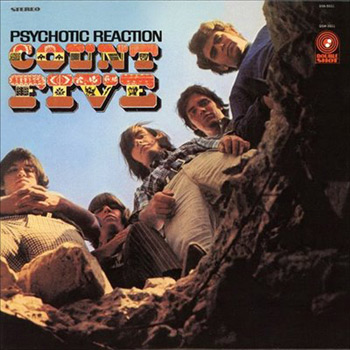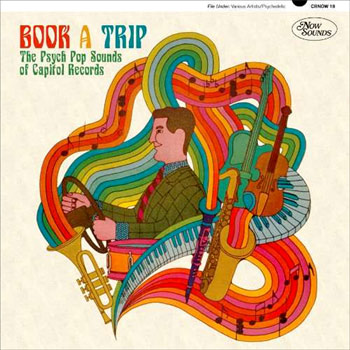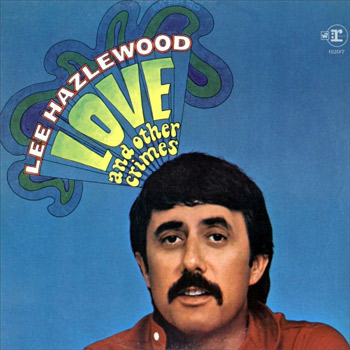Count Five “Psychotic Reaction”

Most fans of garage know Count Five as the group behind the classic single Psychotic Reaction “ a three minute and eight second distillation of everything that’s great about the genre, from its immediately recognizable opening fuzz riff to its last wigged-out break. Eminent garageologists all agree on the track’s importance in the canon, and its inclusion on the original Nuggets LP cemented its hall-of-fame status long ago. But make no mistake, the sum of Count Five is much more than that one single. If you like Psychotic Reaction, you’ll love Psychotic Reaction.
Of course, Psychotic Reaction the album wouldn’t exist but for the success of Psychotic Reaction the single, so some background information is in order. Count Five began in the suburbs of San Jose, California, when John Sean Byrne, recently arrived from Dublin, Ireland, heard The Squires practicing R&B and British Invasion covers in a garage. Byrne asked if he could sit in, and being the closest thing in San Jose to a real Beatle, he was immediately asked to join the band. Flash forward a year, and with competition for bookings becoming increasingly fierce, the quintet attempted to stand out from the rest of the pack by donning vampire capes and becoming Count Five. (Check out this promo shot of the band in full Dracula regalia, awkwardly standing in front of the Winchester Mystery House).
The capes didn’t last long, but as Count Five, the band began to write original material and soon came up with the basic structure of Psychotic Reaction. Although the song was a hit with local audiences, record labels weren’t interested and the band endured months of failed auditions. But Count Five pressed on, revising and reworking Psychotic Reaction until the fledgling Los Angeles label Double Shot decided to take a chance on the song, though it ended up hedging its bet with some last-minute cutting and splicing. (A producer made the wise decision to copy the rave-up section in the middle of the completed track and add it to the end as a fade out). Released as a single in June 1966, Psychotic Reaction began to dominate radio playlists across the country, and was a national top five hit by September. To capitalize on the success of the single, the suits at Double Shot immediately pressured the band to record a full-length album. Yet despite the hurried circumstances of the album’s origin, with songs literally being written in the airplane on the way from San Jose to the studio in Los Angeles, Psychotic Reaction has a high killer-to-filler ratio.
The album was rush-released in October: eleven tracks of caveman stomp and Maestro Fuzz-Tone inside a genius album cover that makes you forget about that earlier promo shot – the band looks like they’ve quickly and ruthlessly disposed of some poor soul foolhardy enough to call them a poor man’s Yardbirds. While none of its tracks overshadow the greatness that is Psychotic Reaction, the shambolic perfection of Pretty Big Mouth comes close. With its propulsive circular fuzz riff, sly lyrics, and brilliant key change at the chorus, the track absolutely nails the smart-aleck swagger every garage band circa-1966 tried to cop to. Peace Of Mind, the follow-up single to Psychotic Reaction, is another contender for best track: an unholy racket of strident, siren-like guitar, surf drumbeats, and heavy doses of controlled feedback, all barely held together by an insistent three-note bass groove. (To these ears, Peace Of Mind sounds similar to the proto-punk the Monks were recording over in Germany around the same time). Unfortunately, AM radio wasn’t quite ready for Peace Of Mind, and the single failed to chart.
While the trio of Psychotic Reaction, Pretty Big Mouth, and Peace Of Mind make this album essential for any garage devotee, there’s also the hopped-up mayhem of Double Decker Bus to consider. While it’s basically a double-time rewrite of their hit single, complete with a rave-up midsection, you won’t hear any complaints from me. Other notable tracks include They’re Gonna Get You, with its falsetto verses and abrupt tempo changes, and the trippy, disoriented vibe of The Morning After. As mentioned above, Psychotic Reaction does contain some filler. The inclusion of two workmanlike Who covers (My Generation and Out In The Street) offer no surprises, and there’s a couple of backward-looking tracks that feel out of place with the rest of the album, such as the beefed-up British Beat of Can’t Get Your Lovin’.
Band members complained in later interviews that due to the hurried nature of the recording sessions, they never had the chance to shape the songs the way they wanted them to sound, but in my opinion, whatever perceived flaws there may be are part of the album’s perfection. Although subsequent non-album singles would sound more assured and incorporate newfangled effects such as the wah-wah pedal, they lacked the raw simplicity of this album. On Psychotic Reaction, there’s nothing fancy, nothing complicated or too clever “ just fuzz and low-end stomp that squarely connect on a primal level. Do yourself a favor and take this album for a spin the next time you’re looking for a garage fix. Your inner teenage punk will thank you for it.
Both mono and stereo versions of the original vinyl album can be found quite easily, but for the last word on Count Five, check out Big Beat’s Psychotic Revelation “ The Ultimate Count Five, which contains the original album in mono, unedited versions of Psychotic Reaction and They’re Gonna Get You, plus non-album singles and essential demos.
Q. Since we’re on the subject, what are your top five U.S. garage singles? Mine are included in the comments below. . .
“Pretty Big Mouth”
![]() Original Vinyl | 1966 | Double Shot | search ebay]
Original Vinyl | 1966 | Double Shot | search ebay]
![]() CD Reissue | 2003 | Big Beat | buy here ]
CD Reissue | 2003 | Big Beat | buy here ]

